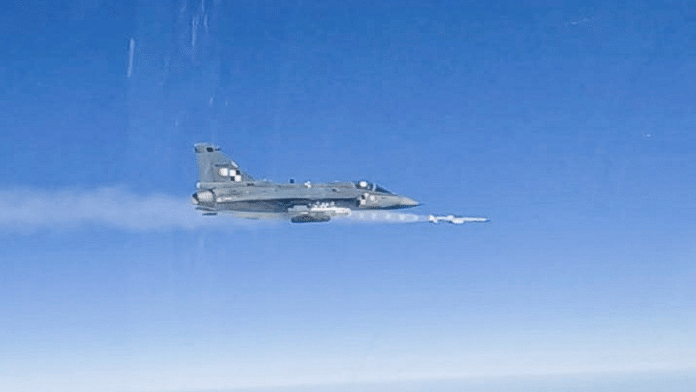ThePrint looks at why India’s first Beyond Visual Range Air-to-Air Missile (BVRAAM) is a gamechanger in aerial warfare and how the project took off.
Astra, meaning “weapon” in Sanskrit, is developed by the Hyderabad-based Defence Research and Development Laboratory (DRDL) under the Defence Research and Development Organisation (DRDO), with production by Bharat Dynamics Limited (BDL).
The Astra Mk1 is capable of striking aerial targets flying at speeds of up to Mach 1.4 (exceeding 1,729 km/hr) at ranges extending to 110 km.
Post-launch, the missile employs inertial mid-course guidance, aided by encrypted data-link updates from the launch aircraft and switches to active radar homing in the terminal phase.
During its development phase, the missile was initially fitted with the Russian-origin Agat 9B1103M active radar seeker, which remained in use for all design validation and live firing trials until 2017.
In parallel, DRDO developed a fully indigenous Ku-band active radar seeker. Designed as a form-fit replacement, this homegrown seeker has now been integrated across all production versions.
back to the early 2000s when it was initiated without formal sanction.
According to the sources, in the absence of sanctioned funding, DRDO began preliminary design work using internal resources.
“The initial major challenges included developing a reliable Radio Frequency (RF) seeker, miniaturised and sturdy missile hardware and integrating the system onto IAF frontline aircraft without any support from the foreign OEM (original equipment manufacturer),” one of the sources told ThePrint.
“DRDO leadership wanted DRDL to demonstrate core capabilities even before the project was formally sanctioned.”
Official clearance for the project was granted in April 2004 and the Su-30MKI was selected as the primary integration platform.
The Astra missile’s initial development began with efforts to validate its performance through ballistic launches from a ground-based launcher. “This was aimed at demonstrating safe and stable release before progressing to manned aircraft trials,” another source said.
In May 2003, three such tests were conducted at the Integrated Test Range in Balasore to establish baseline performance parameters. By 2011, the missile’s configuration was frozen and air-launch testing intensified over the following years.
“Between 2014 and 2019, the missile underwent over 35 air launches and more than 150 captive flight trials,” one of the sources cited above said.
Following a string of successful demonstrations, Astra Mk1 was formally inducted into the Indian Air Force (IAF) in 2019.
Since its induction, Astra Mk1 has been integrated with several frontline platforms including the Su-30MKI. It is being integrated with the LCA Tejas Mk1A. Plans are underway to equip the MiG-29K and IAF’s Rafale as well.
Once integration plans are fully executed, Astra is set to become the standard long-range air-to-air missile across the entire fighter fleet with the exception of the Mirage 2000, which is nearing the end of its operational life.
While the Meteor missile is considered among the most advanced in the world, its high cost and dependence on foreign suppliers make sustained operations during crises strategically limiting.
The cost advantage is significantly notable. Priced at approximately Rs 7–8 crore per unit, the Astra Mk1 offers a substantial saving compared to the French Meteor missile, which costs around Rs 25 crore per unit.
On the other hand, MICA, though versatile, is capped at a range of around 80 km and is now seen as inadequate in modern contested airspaces that demand longer reach and resistance to electronic warfare.
Meanwhile, China’s PL-15 missile, deployed on platforms like J-20 and J-10C, is speculated to have a domestic range of 200–250 km. Even its export variant, the PL-15E, is claimed to offer up to 145 km of engagement envelope.
Pakistan continues to operate the US-supplied AIM-120C5 with an estimated 100 km range and is reportedly collaborating with China on next-generation BVRAAMs. Amid tensions with India over Pahalgam, reports indicate that Pakistan may have received express deliveries of China’s PL-15 missiles.
In this context, Astra’s progressive development becomes central to India’s evolving air power posture. Being homegrown, the system can also be rapidly modified to meet operational requirements without external dependencies.
The long-term vision for air combat supremacy is reflected in the ongoing development of two advanced Astra variants: Mk2 and Mk3.
Expected to be operationally ready by 2026, Astra Mk2 is designed for longer ranges between 140 km and 160 km. It features a dual-pulse rocket motor, upgraded guidance algorithms and the indigenous radio frequency (RF) seeker.
Named ‘Gandiva’, the bow of Arjun, Mk3 is the most ambitious of the Astra family.
Slated for induction by 2031, it is being developed with a solid fuel ducted ramjet (SFDR) propulsion system. This next-gen missile is expected to sustain speeds of Mach 4.5 and strike targets over 300 km away, placing it in the class of modern super-BVRAAMs.
What also distinguishes Astra from most foreign-origin systems is its platform-agnostic design. Imported BVRAAMs are often subject to licensing restrictions, embedded software controls and compatibility constraints that limit their usage across different aircraft types.
“Astra is being developed as a universal missile solution that cuts across both IAF and Navy platforms,” a source said. “This reduces logistical complexity, shortens training cycles and enhances readiness in high-tempo scenarios.”
Beyond its technical features, Astra represents a deliberate move toward operational flexibility and strategic autonomy in critical defence technologies.
(Edited by Tony Rai)








